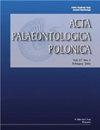Isometry in mesosaurs: implications for growth patterns in early amniotes
IF 1.9
3区 地球科学
Q2 PALEONTOLOGY
引用次数: 2
Abstract
Isometry in Implications for growth patterns in early Mesosaurs were small amphibious tetrapods that lived in western Gondwana during the early Permian or even earlier, when temperate Carboniferous–Permian conditions initiated after the glaciations that affected the southern region of Pangea. In this contribution, we applied traditional linear regression morphometrics to analyse proportions of both the skull and limb bones in more than 100 mesosaur specimens. The analyses revealed that all mesosaur bones scale remarkably close to a model of geometrical similarity (isometry), and that this pattern is particularly strong in long bones and also in the skull. These results indicate that juvenile and adult mesosaurs do not display appreciable change in bone proportions, meaning that there are few or no noticeable differences between them during growth. The well-defined isometry, and particularly, the high interrelation between metatarsals and phalanges permit us to suggest that the mesosaur hind limb is subject to notable modularity. This evidence strongly argues that the differences previously described to support three mesosaur species in Western Gondwana, might instead reflect natural intraspecific variability, taphonomic features or even possible sexual dimorphism, as recently suggested. Our study also reinforces the general plesiomorphic structure of the mesosaur skeleton, which along with some cranial specializations for ecological fitness and the evidence of strong isometric growth as we demonstrate herein, may suggest new hypotheses of relationships for mesosaurs which thus would position them as more basal amniotes than previously thought.中龙的等距:对早期羊膜动物生长模式的影响
早中龙是一种小型两栖四足动物,生活在早二叠纪或更早的冈瓦纳西部,在影响盘古大陆南部地区的冰期之后,温和的石炭纪-二叠纪条件开始了。在这篇文章中,我们应用传统的线性回归形态计量学分析了100多个中龙标本的头骨和肢骨比例。分析显示,所有的中龙骨骼都非常接近几何相似(等距)模型,这种模式在长骨和颅骨中尤为明显。这些结果表明,幼年和成年中龙在骨骼比例上没有明显的变化,这意味着它们在生长过程中几乎没有明显的差异。明确的等距,特别是跖骨和指骨之间的高度相互关系,使我们认为中龙后肢具有显著的模块化。这一证据有力地表明,之前描述的支持冈瓦纳西部三种中龙物种的差异,可能反映了自然的种内变异性、分型学特征,甚至可能是最近提出的两性二态性。我们的研究还强化了中龙骨骼的一般半形结构,以及我们在此展示的一些生态适应性的头骨特化和强等长生长的证据,可能提出了中龙关系的新假设,从而将它们定位为比以前认为的更基础的羊膜动物。
本文章由计算机程序翻译,如有差异,请以英文原文为准。
求助全文
约1分钟内获得全文
求助全文
来源期刊

Acta Palaeontologica Polonica
地学-古生物学
CiteScore
2.80
自引率
5.60%
发文量
36
审稿时长
12.5 months
期刊介绍:
Acta Palaeontologica Polonica is an international quarterly journal publishing papers of general interest from all areas of paleontology. Since its founding by Roman Kozłowski in 1956, various currents of modern paleontology have been represented in the contents of the journal, especially those rooted in biologically oriented paleontology, an area he helped establish.
In-depth studies of all kinds of fossils, of the mode of life of ancient organisms and structure of their skeletons are welcome, as those offering stratigraphically ordered evidence of evolution. Work on vertebrates and applications of fossil evidence to developmental studies, both ontogeny and astogeny of clonal organisms, have a long tradition in our journal. Evolution of the biosphere and its ecosystems, as inferred from geochemical evidence, has also been the focus of studies published in the journal.
 求助内容:
求助内容: 应助结果提醒方式:
应助结果提醒方式:


